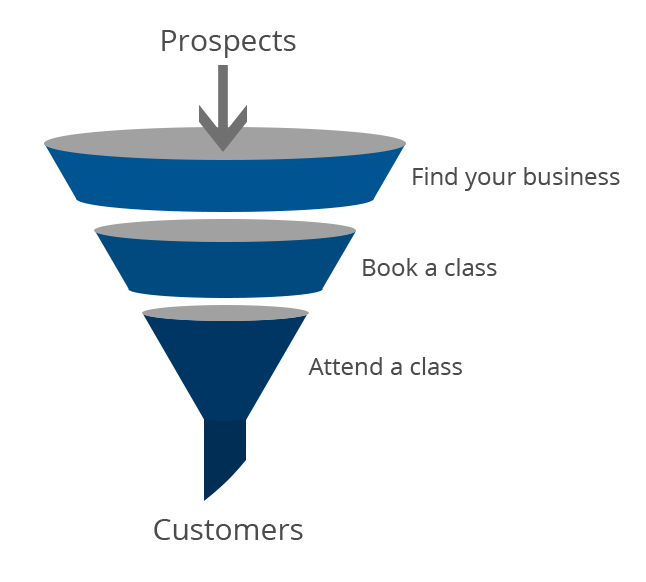Stop Losing Customers to your Booking Process
Conversion Optimisation Basics
A business lives or dies, survives or thrives on the actions of its customers. And if your business relies on bringing in and retaining customers then you need to take a good hard look at your booking process.
The process of winning a customer; getting somebody hand you their hard-earned money, can be visualised as a funnel. A lot of people come in at the top as potential customers (prospects), but as the funnel narrows, more and more people leak out, leaving you with a trickle of customers.
The process of conversion optimisation is looking at that funnel and finding ways to plug leaking holes. The typical funnel for taking bookings is quite simple. Most of our users are businesses that run regular classes (fitness and sport based), and their typical funnel looks like this.

We can break it down further into more granular steps. Each action that has to be taken can be considered a step in the funnel.
- Prospect sees your business on search engine or ad
- Prospect visits your web site
- Prospect finds information about your classes
- Prospect decides to make a booking for a class
- Prospect fills in and submits booking form
- Prospect arrives at your academy for class
- You get paid
Every step of the funnel is important, as a 10% improvement at any stage of the funnel will flow down, essentially resulting in a 10% increase in revenue.
One simple improvement you can make is to increase the discoverability of your classes. Advertise your classes prominently on your home page, immediately visible without the user having to scroll down (in web-design terms, "above the fold").
Make your class schedule easily available. As a general rule, it should take no more than 5 clicks from the home page for a user to find out when and where you hold your classes. Avoid providing the schedule as a pdf, or worse as a Word document.
For many businesses, customers will prioritise location and convenience when choosing the school/academy. Relieve transport related concerns and swing customers from your competitors by displaying maps along with public transport or parking hints.
You haven't won the customer when they decide to make a booking, as the act of making a booking can still be a hurdle. Many users choose to postpone filling long or complicated booking forms (often forgetting to come back to it). Some users straight up abandon the process when they see too many required fields.
Studies show that people don't like to hand over more information than necessary, especially when interacting with a business for the first time. So don't ask for more information than you need; the fewer questions you ask the more bookings you will get.
Although social integration sounds good in theory, sometimes it can go too far. Don't force your customers to shout to their friends that they are coming to your fatburner class. New customers may avoid having to connect socially with your business until they are more comfortable with the customer-business relationship. Do not require your customers to sign in with Facebook as users may abandon the booking process if linking your business to their social sphere feels forced, and prospects without Facebook will immediately be turned away.
If you can avoid it, don't require online payment to secure a booking. Some potential customers may not have access to credit card details, others may refuse to use their credit card online. Although requiring pre-payment or a deposit can reduce no-shows later in the funnel, it has a negative effect on the number of bookings you receive. If the cost of a no-show is large, consider personally following up bookings for confirmation.
If your classes have capacity restrictions, prevent over-booking by restricting bookings to full classes. Dealing with over-bookings can be stressful for you and your customers, and turning away customers on the day will hurt relationships.
Smart-phones and tablet usage has reached record levels, accounting for as much as 24% of web traffic in 2013[1]. With that number set to rise, ignoring mobile devices is now more costly than ever. Manipulating tiny controls and filling out long forms on a small touch screen can be painful so choose a booking system optimised for mobile devices. Furthermore, make sure you test and optimise your web site for mobile devices.
Do not send prospects away from your web-site to make a booking. If you are using an external booking system it should be completely transparent to your prospects. That means it should be able to match the branding, colours and design language of your web site and avoid redirecting traffic off your site. Integration with iframes can be jarring and awkward, so use more seamless integration options.
Conversion optimisation is a powerful tool that can help grow your business. Implementing some of these best-practices on your web site can have a positive effect on your bottom line. If your business relies on bookings, choosing the right booking system can be one of the most important decisions you make.
About Flowbooking
Flowbooking is the intuitive online booking system for classes, events and workshops. It allows your business to take bookings and registrations from your own web site with our embedded widget application. The modern interface is easy to use and saves you time, allowing you to focus on growing your business.